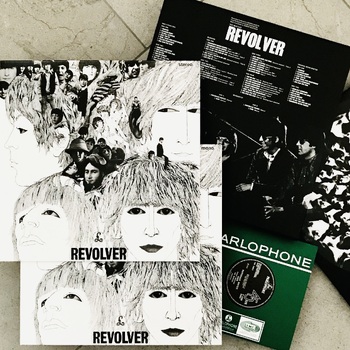REVOLVER
Author: Bruce Jenkins Date Posted:18 November 2022

It would be easy to fill a modestly proportioned suburban house entirely with Beatles paraphernalia. Records, singles, CDs. Re-mixing, remastering, repackaging. Books, magazines and films. It is an industry. So why should anyone care about yet another lavish boxed set re-issue of an album whose next major birthday will be its sixtieth?
Firstly, because it is The Beatles, the four magnificent musicians (and one visionary producer) who were largely responsible for the extraordinary explosion of pop creativity powering that most storied of decades, the Sixties.
Secondly, it is Revolver. The Beatles seventh album was recorded in 1966 after the group had taken their first major break since the circus began, in earnest, three years earlier. John, Paul, George and Ringo were fizzing with ideas and radiating confidence. They revelled in their ability to create new and interesting sounds. Unlike the tired and sometimes fractious group seen in Peter Jackson’s Get Back films, this was a gang who still got a buzz from hanging out together, developing ideas and offering constructive feedback. The result was an album of variety and charm that pushed the boundaries of pop music and kick-started the psychedelic era.
From the chamber pop melancholy of "Eleanor Rigby" to the rocking bounce of "Doctor Robert", from the snarl of "Taxman" to the wistful beauty of "Here, There And Everywhere", this is an LP where every song carries its weight. The contrasts become a delightful part of the ever changing sonic scenery of Revolver as you sing along to "Yellow Submarine" or take a trip into kaleidoscopic inner space with "Tomorrow Never Knows". If the definition of a classic album is one where nothing can be added or subtracted without diminishing it, then Revolver fits the bill.
At the time of Revolver’s recording and release, the dominant format for pop music was mono, both for 7" singles and long-playing records. That is because transistors, TVs and most everyday record players had just one speaker. Stereo had been around a while, but it was an afterthought in terms of mixing the recordings for release. The mono mix was the way The Beatles and their producer George Martin wanted people to hear Revolver so that was where the time and energy was invested. The 2022 edition was cut directly from the original master tape and is bright, immediate and thrilling.
Where the new work appears is in the stereo version. Here, George Martin’s son Giles has used modern techniques (including AI to identify individual voices and instruments on the tapes) to deconstruct the original recordings and re-mix them. The results can be a little unsettling for those familiar with the rather blunt 1966 stereo mix yet they are also revelatory, with detail and interplay never before audible, now sparkling into life.
Throughout their careers, George Martin and the Beatles were innovative and experimental in their approach to technology, yet never more so than during 1966 and 1967. One spectacular example is the improvement in capturing low frequency sounds, such as Paul McCartney’s bass guitar playing. Drop the stylus on opening song "Taxman" and you will hear it immediately. This clearer, cleaner bass sound is perhaps best illustrated in the single The Beatles released in May of 1966, some three months before Revolver. "Paperback Writer" (McCartney lead vocal) b/w "Rain" (Lennon lead vocal) blew minds at the time and still sounds brilliant today. The inclusion of a 7" single with the two songs in glorious mono on one side and re-mixed stereo on the other is a lovely touch and completes the picture of this key Beatles year.
We’ve talked about the finished songs but as all Beatle fans know, many were workshopped from fragments or developed in collaboration (mainly between John Lennon and Paul McCartney). The newly compiled double album Revolver Sessions included in this boxed set collates work-in-progress recordings in a thoughtful way that shines new light on the creative process.
All in all, the four LPs plus the 45 RPM single present a detailed and satisfying picture of a timeless record. The beautifully produced book adds to the luxurious feel of this definitive release. Particularly welcome is an excerpt from artist/musician Klaus Voorman’s graphic text about his creation of the iconic cover.
The entire package is one to enjoy and treasure.
© Bruce Jenkins—November 2022

